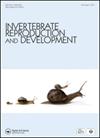Growth, survival and reproduction of the Turkish medicinal leech, Hirudo sulukii
IF 0.8
4区 生物学
Q4 REPRODUCTIVE BIOLOGY
引用次数: 3
Abstract
ABSTRACT The present study aimed to investigate growth, survival and reproduction of the Turkish medicinal leech, Hirudo sulukii, endemic to Southeastern Anatolia and whose biology is poorly understood. In comparison with the Southern medicinal leech, Hirudo verbana, which has a wide distribution throughout Eurasia, H. sulukii grew faster until the fourth month, then growth increased significantly in favour of H. verbana. At the beginning of gravidity, high mortality occurred in specimens of H. sulukii not transferred to moist peat, the cocoon deposition area. Gravidity occurred in almost all (98%) H. sulukii adults, but was detected in only 60% of H. verbana adults. Unlike the growing period, survival rate was greater in H. sulukii during the reproductive period. Gravidity and cocoon laying periods lasted longer in H. sulukii, which continued reproductive activity even in colder conditions. There were more and smaller sized cocoons having higher deformation rate in H. sulukii. Likewise, fewer and larger offspring having lower morphological abnormality were observed in cocoons having lower hatchling rates in H. sulukii. Collectively, our findings reveal that H. sulukii reaches adult size relatively early, continues its reproduction in cold conditions and displays high reproductive performance, thus making it a strong candidate for leech aquaculture.土耳其药用水蛭的生长、生存和繁殖
摘要本研究旨在研究土耳其药用水蛭苏鲁奇水蛭的生长、存活和繁殖,该水蛭原产于安纳托利亚东南部,其生物学特性尚不清楚。与在欧亚大陆广泛分布的南方药用水蛭马鞭草相比,苏鲁基水蛭在第四个月之前生长得更快,然后生长显著增加,有利于马鞭草。在怀孕初期,没有转移到潮湿泥炭地(茧沉积区)的苏鲁基H.sulukii标本死亡率很高。几乎所有(98%)苏鲁基H.成虫都发生了妊娠,但只有60%的马鞭草成虫发生了妊娠。与生长期不同的是,在繁殖期,苏鲁基H.的存活率更高。苏鲁基海象的妊娠期和产茧期持续时间较长,即使在较冷的条件下也能继续繁殖活动。苏鲁基蚕茧越来越多,体积越来越小,变形率越来越高。同样,在苏鲁基H.孵化率较低的茧中观察到具有较低形态异常的较小和较大的后代。总的来说,我们的研究结果表明,苏鲁基水蛭相对较早达到成虫大小,在寒冷条件下继续繁殖,并表现出较高的繁殖性能,从而使其成为水蛭养殖的有力候选者。
本文章由计算机程序翻译,如有差异,请以英文原文为准。
求助全文
约1分钟内获得全文
求助全文
来源期刊
CiteScore
1.90
自引率
0.00%
发文量
21
审稿时长
>12 weeks
期刊介绍:
Invertebrate Reproduction & Development ( IRD) presents original research on the reproductive and developmental biology of the Invertebrata, both embryonic and postembryonic. IRD welcomes papers reporting significant results obtained using new techniques. Encouraged topic areas include: aquaculture, physiology, biochemistry, functional morphology, phylogeny, behavioural and regulatory mechanisms, including genetic, endocrine and molecular studies. Papers containing qualitative descriptions of reproductive cycles and gametogenesis will not be considered. IRD is published in association with the International Society of Invertebrate Reproduction and Development.

 求助内容:
求助内容: 应助结果提醒方式:
应助结果提醒方式:


